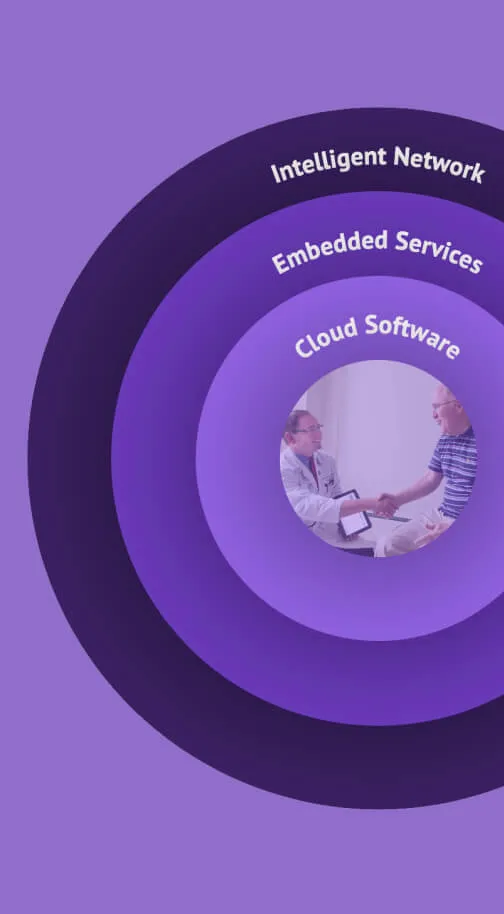What to know about fee-for-value, quality incentives, shared savings and risk, and global capitation
Is value-based care (VBC) right for you? To answer that question, you need to understand the variety of healthcare reimbursement models that make up the category of VBC.
The four primary types of value-based healthcare programs—fee-for-value, quality incentives, shared savings and risk, and global capitation—sit on a spectrum of risk, complexity, and scale, and your goals as a healthcare organization will determine which program, or combination of programs, will most benefit you and your patients.
Each of these value based payment models has been designed to work alongside the most common healthcare payment model—fee-for-service. Under fee-for-service, physicians and medical practices are reimbursed for the quantity of services that are provided to patients, not necessarily the health outcomes that those services drive. Fee-for-service is still the bedrock of the US healthcare system, but it’s also to blame for the high healthcare costs and relatively poor health outcomes the US achieves each year.1
Physicians and practice managers need to first understand the reasons for the shift to value-based care models and what skills your organization needs to succeed with VBC.
Let’s take a closer look at the main payment models that make up value-based care, starting with the model that presents the lowest risk to physicians and moving up from there.2
What is fee-for-value?
Fee-for-value is a healthcare payment model designed to compensate medical practices for delivering high-quality, effective care to patients while keeping costs down. Under this model, healthcare organizations receive higher reimbursement payments when they provide value to patients above and beyond the scope of a typical office visit. Typically, these programs incentivize preventative care and chronic disease management with the goal of reducing emergency visits and hospitalizations.
Fee-for-value programs may be a good starting place if you’re looking to test out value-based medical care for the first time. That’s because the fee-for-value payment model presents the lowest level of financial risk among the various payment models.3
Examples of fee-for-value programs
Two examples of fee-for-value reimbursement models are Medicare’s Chronic Care Management4 and Transitional Care Management5 programs. These CMS value-based models reward healthcare providers for delivering value to patients between visits to the exam room.
For example, under Chronic Care Management a practice can be compensated for enrolling qualifying patients—i.e., those with two-or-more chronic conditions like arthritis, cardiovascular disease, diabetes, and others— in a chronic care management program that may include services like a dedicated care team member, increased access to a physician or a care team, preventative care, and patient monitoring.
What are the benefits of fee-for-value programs?
Medical practices choose fee-for-value programs like Medicare’s Chronic Care Management because they are lower risk, fairly easy to implement, and can often generate new revenue for services a practice may already be providing to patients.6
Here are some of the main benefits of leveraging fee-for-value programs:
- They are structured to be low-risk and relatively easy to implement
- Can provide an additional revenue stream in addition to fee-for-service
- You may be able to leverage fee-for-value programs to be compensated for work you’re already doing
These programs are a good testing ground for healthcare organizations considering branching into value-based care models or adding new services Potential drawbacks of fee-for-value programs:
- Potential payouts are smaller than for other higher risk-based payment models
- Standing up a new chronic or transitional care program may require additional time and resources
What are healthcare quality incentives?
Quality incentives are a category of healthcare payment model that incentivizes healthcare providers to meet certain quality- and performance- based metrics for a defined set of patients. Quality incentives work alongside the fee-for-service model by offering payments above and beyond normal reimbursements.
One key difference between quality incentives and fee-for-value programs is that, with quality incentives, poor performance can lead to a negative financial incentive, or penalty. This makes quality incentives inherently riskier than fee-for-value.
Examples of quality payment programs
Medicare’s Merit-based Incentive Payment System (MIPS)7 is one of the most popular quality incentive programs available today. MIPS, which was created under the Medicare Access and CHIP Reauthorization Act (MACRA) is a performance-based incentive specifically designed for Medicare Part B providers.8
If you participate in MIPS, you must track certain parameters in an EHR system, commit to coordinating care electronically, and close certain care gaps based on clinical objectives. Organizations that do so receive a bonus payout.
Additional quality incentive programs include:
- Patient-Centered Medical Home (PCMH): incentivizes high-quality, cost-effective care delivered through coordinated patient care across the health system9
- Patient-Centered Specialty Practice program (PCSP): extends PCMH its benefits to specialty practices10
- Primary Care First (PCF): designed to improve quality and patient experiences while reducing expenditures11
The four primary types of value-based healthcare programs—fee-for-value, quality incentives, shared savings and risk, and global capitation—sit on a spectrum of risk, complexity, and scale
What are the benefits of quality incentives programs?
The Centers for Medicare & Medicaid Services (CMS) requires many providers who receive Medicare to participate in quality measures like MIPS and has a goal of reaching 100% participation by 2030.12
Many healthcare organizations who aren’t required to still participate in quality incentive programs because they can increase profit margins and generate additional revenue on top of a fee-for-service model. And, of course, they drive improved outcomes for patients.
Here are some of the main benefits of leveraging quality incentives:
- Quality incentives pay you for delivering high-quality healthcare to patients while also lowering costs
- Incentive payments can help diversify revenue streams and increase profit margins
- While they do involve some risk, quality incentives are significantly less risky that other models like shared savings and risk and global capitation
Potential drawbacks of quality incentives:
- Quality incentives come with some degree of financial risk, including penalties and/or withholdings for failing to meet program performance criteria
- Performance metrics may be weighted differently, which can make calculating reimbursements complicated and may require a specialized practice management system
What is shared savings and risk payment program?
Shared savings and risk is a payment model under which healthcare organizations are responsible for the total cost of a certain group of patients’ care. If those costs are managed well—for instance, by reducing hospitalizations and situations requiring catastrophic care—the organization is rewarded; if costs exceed the designated amount, the organization is penalized. Put simply, these programs encourage practices to manage higher risk patients and those with chronic conditions to keep them healthier and drive costs down.
These programs work because two forms of risk are built into them—upside risk and downside risk. In short, the potential for reward (upside) and the potential for loss (downside).
Examples of shared savings/risk programs
The Medicare Shared Savings Program (MSSP)13 is a prominent example of a shared savings/risk program.
Under MSSP, Accountable Care Organizations (ACOs) “give coordinated high-quality care to people with Medicare, focusing on delivering the right care at the right time, while avoiding unnecessary services and medical errors.”14 If an ACO can collaborate to deliver high-quality care to patients while keeping costs down, they receive a share of the savings they’ve produced. That money is then distributed to the medical practices who participate in the ACO.
Many commercial payers also offer shared savings and risk opportunities.
What are the benefits of shared savings and risk programs?
Compared with fee-for-value and quality incentives programs, shared savings and risk programs are both riskier and potentially more financially rewarding for the practices that utilize them.
Here are some of the top benefits of participating in shared savings and risk programs:
- Such programs are designed to enable and incentivize improved patient outcomes and lower costs
- These programs tend to work best for larger, independent medical groups and formal networks like ACOs, Management Services Organizations (MSOs), Clinically Integrated Networks (CINs), and Independent Physician Associations (IPAs) because these organizations typically have the resources to take on greater downside risk in favor of larger financial incentives
- While riskier than some other payment models, financial penalties are sometimes mitigated with caps on downside risk so organizations know the maximum penalty they may have to pay
- Small and mid-sized practices that want to leverage shared savings and risk programs may be best equipped to do so by maintaining membership in a larger organization, like an ACO
Potential drawbacks of shared savings and risk programs:
- Shared savings and risk programs are significantly riskier than fee-for-service and quality incentives, and providers who are not equipped with the tools and expertise to manage them can hurt their financial health
- Interoperability is a key element of shared savings and risk, so practices without an interoperable healthcare IT solution for electronic health records may struggle to meet requirements
What are capitation payment models?
What is capitation in healthcare? Global capitation is a healthcare payment model that pays healthcare organizations a set amount per month for each patient on a particular contract or panel. Global capitation programs are designed to improve patient health outcomes and keep the costs associated with that care as low as possible. They can also provide a predictable revenue stream for medical practices that is often paid up-front, rather than trailing the performance year.
Compared with other risk-based payment models, healthcare capitation presents the greatest opportunity for both reward and penalty. For this reason, it is sometimes referred to as “full risk.” On the upside, practices that manage costs below the amount of the capitation payment keep the surplus. Those that exceed the payment amount must make up the difference.
Examples of global capitation programs
Here are a few examples of global capitation programs available to healthcare providers today:
- Program of All-Inclusive Care for the Elderly (PACE): PACE is designed to deliver full medical and social services to certain elderly people within a community, outside of a nursing or care home setting15
- Medicare Advantage: Medicare Advantage is a common global capitation program that is offered to patients as an alternative to Traditional Medicare16
- Accountable Care Organization Realizing Equity, Access, and Community Health (ACO Reach): ACO REACH is designed to improve care for people on Traditional Medicare by providing tools and resources to providers that would like to work within an ACO17
What are the benefits of participating in global capitation programs?
Global capitation programs may be attractive to healthcare organizations because they can generate significant revenue when their patients’ care is managed and executed well.
Here are some of the top benefits of participating in global capitation programs:
- Practices often receive a monthly up-front payment for the patients enrolled in a capitation program which supports cashflow and financial stability
- Many programs provide you with quite a bit of leeway in how you manage costs, so savings can be significant
- Capitation programs incentivize patient outcomes, and healthier patients cost less to provide care for
Potential drawbacks of global capitation programs:
- Because of the high-level of risk associated with capitation, these programs tend to be most appealing to larger organizations with both the financial reserves and administrative resources needed to mitigate financial risk and confidently managed these complex programs
- Medical practices without a robust healthcare IT infrastructure—including tools for analyzing population health and other analytics— will struggle to manage the data-driven requirements of capitation programs
Value-based healthcare: what’s ahead
Value-based care is here to stay. In fact, McKinsey estimates that 90 million people will receive care under VBC models by 2027, a 109% increase since 2022.18 That number will continue to grow, especially as CMS works toward its goal of full participation by 2030. The hope is that this shift toward more outcome- and value-oriented healthcare will produce a healthier population at a lower cost.
If you’re interested in learning more about value-based healthcare and risk-based payment models, read the articles below.
The Commonwealth Fund, Aug. 2021, Mirror, Mirror 2021: Reflecting Poorly; https://www.commonwealthfund.org/publications/fund-reports/2021/aug/mirror-mirror-2021-reflecting-poorly
CMS, Aug. 2023, Risk-Based Arrangements in Health Care; https://www.cms.gov/priorities/innovation/key-concepts/risk-based-arrangements-health-care
Ibid.
CMS, May 2024, Chronic Care Management Services; https://www.cms.gov/outreach-and-education/medicare-learning-network-mln/mlnproducts/downloads/chroniccaremanagement.pdf
CMS, July 2024, Transitional Care Management Services; https://www.cms.gov/files/document/mln908628-transitional-care-management-services.pdf
American Medical Association, Apr. 2014, Physician Payment Reform: Where Do I Fit In? Dividing the Pie In New Payment Models; https://www.ama-assn.org/sites/ama-assn.org/files/corp/media-browser/wash/innovators-committee-physician-payment-reform-white-paper.pdf
Quality Payment Program, Traditional MIPS Overview; https://qpp.cms.gov/mips/traditional-mips
CMS, Sept. 2024, MACRA; https://www.cms.gov/medicare/quality/value-based-programs/chip-reauthorization-act
CDC, May 2024, Patient-Centered Medical Home (PCMH) Model; https://www.cdc.gov/cardiovascular-resources/php/pcmh-model/index.html
National Library of Medicine, April 2017, Patient-Centered Specialty Practice: Defining the Role of Specialists in Value-Based Health Care; https://pubmed.ncbi.nlm.nih.gov/28089817/
CMS, Primary Care First (PCF) Model: Evaluation of the First Year (2021), https://www.cms.gov/priorities/innovation/data-and-reports/2022/pcf-first-eval-aag-rpt
CMS, June 2023, The CMS Innovation Center’s Strategy to Support High-quality Primary Care; https://www.cms.gov/blog/cms-innovation-centers-strategy-support-high-quality-primary-care
CMS, Nov. 2024, Shared Savings Program; https://www.cms.gov/medicare/payment/fee-for-service-providers/shared-savings-program-ssp-acos
CMS, Shared Savings Program; https://www.cms.gov/medicare/payment/fee-for-service-providers/shared-savings-program-ssp-acos
CMS, Oct. 2024, Program of All-Inclusive Care for the Elderly (PACE); https://www.cms.gov/medicare/medicaid-coordination/about/pace
Medicare.gov, Nov. 2024, Understanding Medicare Advantage Plans; https://www.medicare.gov/publications/12026-understanding-medicare-advantage-plans.pdf
CMS, Feb. 2022, Accountable Care Organization (ACO) Realizing Equity, Access, and Community Health (REACH) Model; https://www.cms.gov/newsroom/fact-sheets/accountable-care-organization-aco-realizing-equity-access-and-community-health-reach-model
McKinsey & Company, Jan 2024, What to expect in US healthcare in 2024 and beyond, https://www.mckinsey.com/industries/healthcare/our-insights/what-to-expect-in-us-healthcare-in-2024-and-beyond













